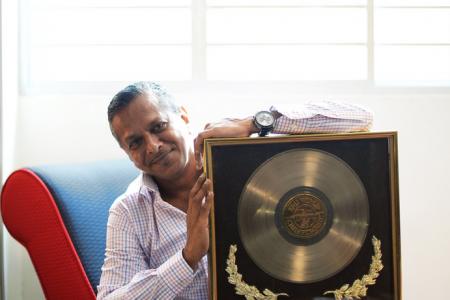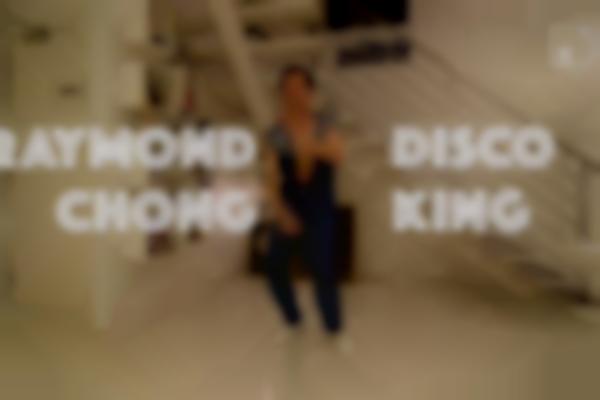Disco was a way of life
Most people know disco for its flashy costumes and packed nightclubs.
But for event planner Derek Joseph, 55, disco was a way of life.
He would know. Back in 1979, Mr Joseph was Singapore's first representative to the EMI World Disco Dancing Championship, where he finished sixth.
Mr Joseph tells The New Paper on Sunday: "It was something we all enjoyed together at each other's house parties.
"It was all we had back then - you must remember this was a time before the Internet or even CD players."
WINNER: He wore a kurta - a traditional Indian outfit - while representing Singapore in the international competition. PHOTO: YOUTUBE
Mr Joseph says many of the nights in his early teenage years were filled with these house parties. Disco music had debuted in the early 1970s, and it was all people danced to.
Mr Joseph, who is married with two teenage boys, became fascinated with the music and would even mimic the performances he saw.
His biggest inspiration? Michael Jackson.
"Every weekend without fail, I would press my face against the television, watch him on The Jackson 5 and copy their performances," says Mr Joseph.
All that practising showed in his dancing, and Mr Joseph says his friends would always single him out for his moves.
At their insistence, Mr Joseph signed up for the first Singapore Disco Dancing Competition, which he describes as a "nerve-racking experience".
He says: "I had only danced for fun, but this was a whole other thing altogether."
In order to set himself apart from the other competitors, he decided to incorporate Indian dance influences into his performance.
"I needed a winning card, something to set me apart from the rest. Luckily, my friend's sister could teach me the traditional dance steps," he says.
KURTA
But the dance steps were not enough. A few days before the competition, he went to Serangoon to buy a kurta - a traditional Indian outfit - to perform in.
His efforts paid off. Mr Joseph placed first and flew to London to represent Singapore - all at the age of 17.
It was his first time overseas, and Mr Joseph says the level of competition at the international championship was unprecedented.
He says: "I remember walking up to the dance floor - it was the biggest I had ever seen in my life.
"There were hundreds of mirror balls and people were flying around and somersaulting."
Sticking to what he knew best, Mr Joseph put on the kurta - only this time it was made by a professional and adorned with sequins. He continued adding an Indian dance twist to his moves too.
"It was important to be different, especially at the international stage," he says.
Although he did not place in the top five, Mr Joseph counts himself lucky that he managed to even make it to the finals, a feat he says he had never dreamt of achieving.
A video of the 1979 disco championships has been spreading online recently. Mr Joseph says watching it brought back plenty of good memories.
"I was surprised, because it's still there after so many years. At first, I watched it and kept quiet, because I'm easily embarrassed," he says.
He adds with a laugh: "Somehow my brother saw it. Next thing you know, everyone, even my boys, were watching. If I were 22, it would be cool. But at this age, I was a bit shy."
Despite the embarrassment, Mr Joseph says he is proud as it was rare for Singapore to be represented on the international stage.
He says: "Finally Singapore appeared somewhere at the time. It was a good feeling."
As he excitedly flips through his collection of photographs from the time, Mr Joseph says: "I'm so fortunate to have been able to represent Singapore."
Disco fever ended as quickly as it started
Disco here did not start out in dance clubs.
Mr Derek Joseph says that in the early 1970s, the dance style was more common at house parties than the Zouk clubs of its day.
"It was not always about flashy dance floors," he says.
"People would just be dancing together at house parties. No need for a fancy bar or even alcohol. They danced because they loved the music."

Even the popular disco attire, characterised by bell bottom pants and fancy sequins, was reserved only for special occasions.
Mr Joseph says: "It didn't matter what you wore, as long as you were having a good time."
Over time, the disco inferno engulfed the local dancing scene. Nightclubs all across the island started playing disco music.
Mr Raymond Chong says: "The main places to dance disco included Studio M, Copacabana and Goodwood Park. The queues were always long, and people could not wait to get into the club."
Both dancing champions say the dance style was such a hit that people would be dancing even at weddings or private functions.
FIZZLE OUT
But as quickly as it exploded, disco started fizzling out in the 1980s.
The soaring vocals and steady beats of disco made way for the thumping sounds of electronic music.
"By the 1990s, artists didn't make any more disco music. It was seldom played, replaced by other kinds of music that people liked," says Mr Chong.
But regardless of how long it has been, die-hard disco fans say the music will always survive.
Mr Joseph says: "It's the most honest and pure music out there. It allows you to express yourself and be creative. There will never be anything like disco."
Get The New Paper on your phone with the free TNP app. Download from the Apple App Store or Google Play Store now



